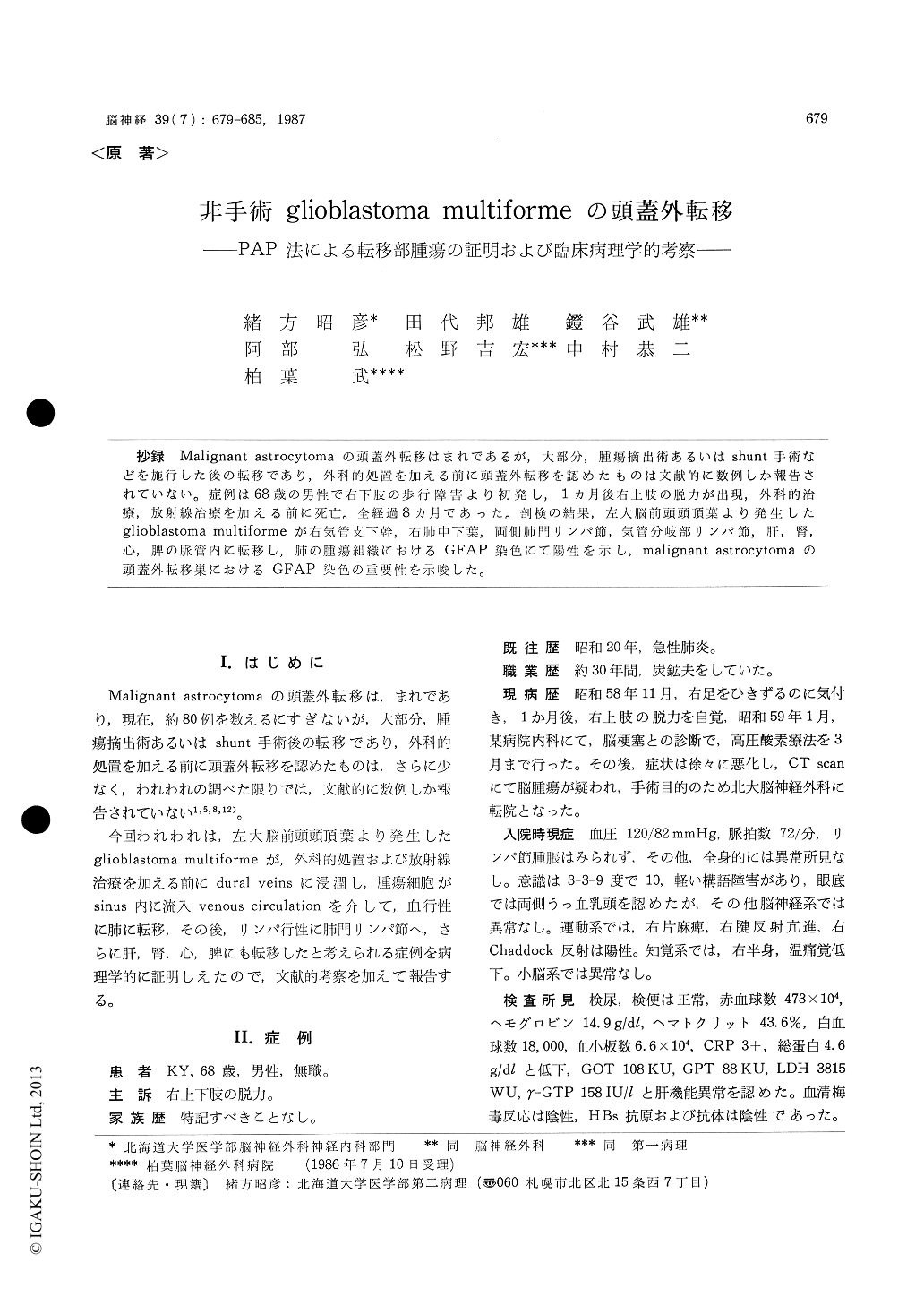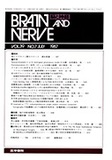Japanese
English
- 有料閲覧
- Abstract 文献概要
- 1ページ目 Look Inside
抄録 Malignant astrocytomaの頭蓋外転移はまれであるが,大部分,腫瘍摘出術あるいはshunt手術などを施行した後の転移であり,外科的処置を加える前に頭蓋外転移を認めたものは文献的に数例しか報告されていない。症例は68歳の男性で右下肢の歩行障害より初発し,1ヵ月後右上肢の脱力が出現,外科的治療,放射線治療を加える前に死亡。全経過8ヵ月であった。剖検の結果,左大脳前頭頭頂葉より発生したglioblastoma multiformeが右気管支下幹,右肺中下葉,両側肺門リンパ節,気管分岐部リンパ節,肝,腎,心,脾の脈管内に転移し,肺の腫瘍組織におけるGFAP染色にて陽性を示し,malignant astrocytomaの頭蓋外転移巣におけるGFAP染色の重要性を示唆した。
Spontaneous extracranial metastases of gliobla-stoma multiforme in the absence of previous sur-gery have been rarely reported (Table 1). We presented an autopsy case of glioblastoma multi-forme which spontaneously metastasized to the lungs, bronchial lymph nodes, liver, kidney, heart and spleen.
A 68-year-old man was admitted to the Depart-ment of Neurosurgery at our hospital with chief complaints of right sided weakness in July 1984. He was well until November 1983, when he no-ticed weakness of right lower extremity followed one month later by the weakness in the right arm. He was treated at another hospital under the diagnosis of cerebral infarction, but his right sided weakness gradually progressed. In June 1984, a diagnosis of brain tumor was made by the neurological findings and CT scan, and he was transferred to our hospital for further evaluation and treatment. Neurological examination revealed disorientation, bilateral papilledema, right hemi-paresis, right hyperreflexia and right hemisensory disturbance. CT scan revealed abnormal low den-sity area in the left fronto-parietal lobe (Fig. 1) with irregular enhanced lesions on contrast CT scan (Fig. 2). Chest x-ray showed abnormal sha-dow in the right middle and lower lobe (Fig. 3) and a diagnosis of pulmonary infarction was sus-pected. The clinical states of this patient took downhill course and he expired on July 13, 1984 by the complication of disseminated intravascular coagulation syndrome.
The brain weight was 1400 gr. Dura mater and falx cerebri were tightly adherent to the left parietal lobe (Fig. 4). Primary brain tumor was found in the left fronto-parietal region. The tumor was poorly defined with necrosis and he-morrhage (Fig. 5).
Microscopically there were the pleomorphism and hypercellurarity of astrocytes with spindle-shaped cells, giant cells and numerous mitoses (Fig. 6) in addition to the extensive necrosis. Reticulin stain of this tumor was negative (Fig.7). Histological diagnosis was compatible with gioblastoma multiforme. Tumor cells were iden-tified in the small venous spaces of the dura (Fig. 8 a, b). Histological features of all metas-tatic sites had a strong resemblance to that of the primary brain tumor (Fig. 9a). Peroxidase-antiperoxidase stain for glial fibrillary acidic pro-tein (GFAP) on the lung tissue showed reactive products of GFAP (Fig. 9b).
The present case demonstrated that glioblastoma multiforme could spontaneously metastasize to the extracranial sites by way of the venous circulation through the small venous spaces of the dura. The importance of tumor cell identifications in the small venous spaces of the dura was stressed as the one of the routes of extracranial metastases in glioblastoma multiforme.

Copyright © 1987, Igaku-Shoin Ltd. All rights reserved.


